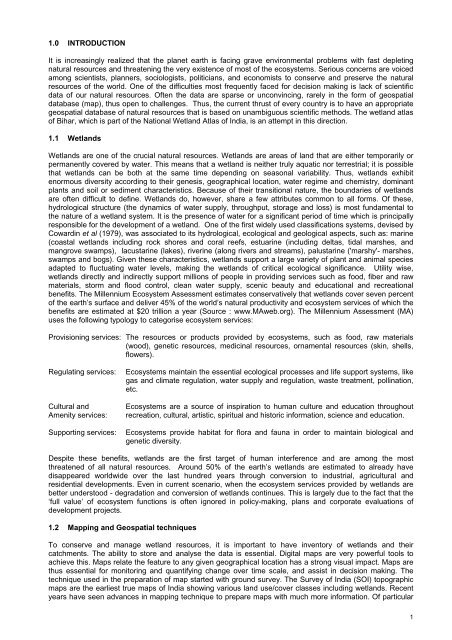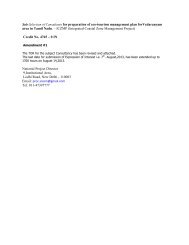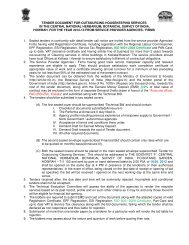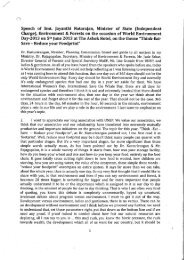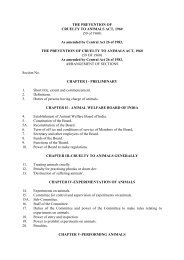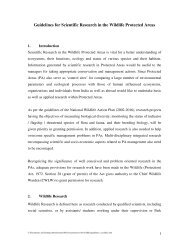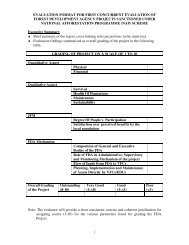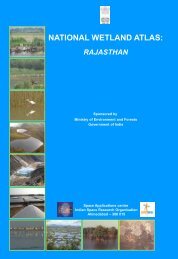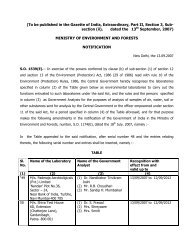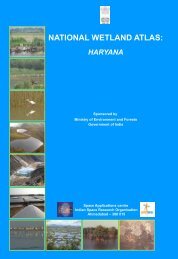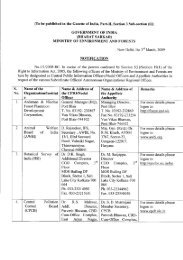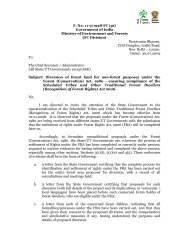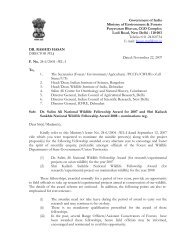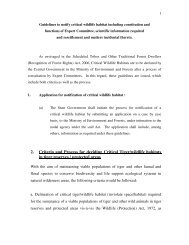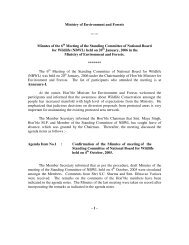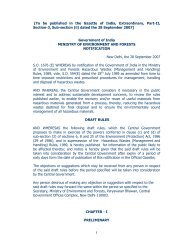Bihar - Ministry of Environment and Forests
Bihar - Ministry of Environment and Forests
Bihar - Ministry of Environment and Forests
- No tags were found...
Create successful ePaper yourself
Turn your PDF publications into a flip-book with our unique Google optimized e-Paper software.
1.0 INTRODUCTION<br />
It is increasingly realized that the planet earth is facing grave environmental problems with fast depleting<br />
natural resources <strong>and</strong> threatening the very existence <strong>of</strong> most <strong>of</strong> the ecosystems. Serious concerns are voiced<br />
among scientists, planners, sociologists, politicians, <strong>and</strong> economists to conserve <strong>and</strong> preserve the natural<br />
resources <strong>of</strong> the world. One <strong>of</strong> the difficulties most frequently faced for decision making is lack <strong>of</strong> scientific<br />
data <strong>of</strong> our natural resources. Often the data are sparse or unconvincing, rarely in the form <strong>of</strong> geospatial<br />
database (map), thus open to challenges. Thus, the current thrust <strong>of</strong> every country is to have an appropriate<br />
geospatial database <strong>of</strong> natural resources that is based on unambiguous scientific methods. The wetl<strong>and</strong> atlas<br />
<strong>of</strong> <strong>Bihar</strong>, which is part <strong>of</strong> the National Wetl<strong>and</strong> Atlas <strong>of</strong> India, is an attempt in this direction.<br />
1.1 Wetl<strong>and</strong>s<br />
Wetl<strong>and</strong>s are one <strong>of</strong> the crucial natural resources. Wetl<strong>and</strong>s are areas <strong>of</strong> l<strong>and</strong> that are either temporarily or<br />
permanently covered by water. This means that a wetl<strong>and</strong> is neither truly aquatic nor terrestrial; it is possible<br />
that wetl<strong>and</strong>s can be both at the same time depending on seasonal variability. Thus, wetl<strong>and</strong>s exhibit<br />
enormous diversity according to their genesis, geographical location, water regime <strong>and</strong> chemistry, dominant<br />
plants <strong>and</strong> soil or sediment characteristics. Because <strong>of</strong> their transitional nature, the boundaries <strong>of</strong> wetl<strong>and</strong>s<br />
are <strong>of</strong>ten difficult to define. Wetl<strong>and</strong>s do, however, share a few attributes common to all forms. Of these,<br />
hydrological structure (the dynamics <strong>of</strong> water supply, throughput, storage <strong>and</strong> loss) is most fundamental to<br />
the nature <strong>of</strong> a wetl<strong>and</strong> system. It is the presence <strong>of</strong> water for a significant period <strong>of</strong> time which is principally<br />
responsible for the development <strong>of</strong> a wetl<strong>and</strong>. One <strong>of</strong> the first widely used classifications systems, devised by<br />
Cowardin et al (1979), was associated to its hydrological, ecological <strong>and</strong> geological aspects, such as: marine<br />
(coastal wetl<strong>and</strong>s including rock shores <strong>and</strong> coral reefs, estuarine (including deltas, tidal marshes, <strong>and</strong><br />
mangrove swamps), lacustarine (lakes), riverine (along rivers <strong>and</strong> streams), palustarine ('marshy'- marshes,<br />
swamps <strong>and</strong> bogs). Given these characteristics, wetl<strong>and</strong>s support a large variety <strong>of</strong> plant <strong>and</strong> animal species<br />
adapted to fluctuating water levels, making the wetl<strong>and</strong>s <strong>of</strong> critical ecological significance. Utility wise,<br />
wetl<strong>and</strong>s directly <strong>and</strong> indirectly support millions <strong>of</strong> people in providing services such as food, fiber <strong>and</strong> raw<br />
materials, storm <strong>and</strong> flood control, clean water supply, scenic beauty <strong>and</strong> educational <strong>and</strong> recreational<br />
benefits. The Millennium Ecosystem Assessment estimates conservatively that wetl<strong>and</strong>s cover seven percent<br />
<strong>of</strong> the earth’s surface <strong>and</strong> deliver 45% <strong>of</strong> the world’s natural productivity <strong>and</strong> ecosystem services <strong>of</strong> which the<br />
benefits are estimated at $20 trillion a year (Source : www.MAweb.org). The Millennium Assessment (MA)<br />
uses the following typology to categorise ecosystem services:<br />
Provisioning services: The resources or products provided by ecosystems, such as food, raw materials<br />
(wood), genetic resources, medicinal resources, ornamental resources (skin, shells,<br />
flowers).<br />
Regulating services:<br />
Cultural <strong>and</strong><br />
Amenity services:<br />
Supporting services:<br />
Ecosystems maintain the essential ecological processes <strong>and</strong> life support systems, like<br />
gas <strong>and</strong> climate regulation, water supply <strong>and</strong> regulation, waste treatment, pollination,<br />
etc.<br />
Ecosystems are a source <strong>of</strong> inspiration to human culture <strong>and</strong> education throughout<br />
recreation, cultural, artistic, spiritual <strong>and</strong> historic information, science <strong>and</strong> education.<br />
Ecosystems provide habitat for flora <strong>and</strong> fauna in order to maintain biological <strong>and</strong><br />
genetic diversity.<br />
Despite these benefits, wetl<strong>and</strong>s are the first target <strong>of</strong> human interference <strong>and</strong> are among the most<br />
threatened <strong>of</strong> all natural resources. Around 50% <strong>of</strong> the earth’s wetl<strong>and</strong>s are estimated to already have<br />
disappeared worldwide over the last hundred years through conversion to industrial, agricultural <strong>and</strong><br />
residential developments. Even in current scenario, when the ecosystem services provided by wetl<strong>and</strong>s are<br />
better understood - degradation <strong>and</strong> conversion <strong>of</strong> wetl<strong>and</strong>s continues. This is largely due to the fact that the<br />
‘full value’ <strong>of</strong> ecosystem functions is <strong>of</strong>ten ignored in policy-making, plans <strong>and</strong> corporate evaluations <strong>of</strong><br />
development projects.<br />
1.2 Mapping <strong>and</strong> Geospatial techniques<br />
To conserve <strong>and</strong> manage wetl<strong>and</strong> resources, it is important to have inventory <strong>of</strong> wetl<strong>and</strong>s <strong>and</strong> their<br />
catchments. The ability to store <strong>and</strong> analyse the data is essential. Digital maps are very powerful tools to<br />
achieve this. Maps relate the feature to any given geographical location has a strong visual impact. Maps are<br />
thus essential for monitoring <strong>and</strong> quantifying change over time scale, <strong>and</strong> assist in decision making. The<br />
technique used in the preparation <strong>of</strong> map started with ground survey. The Survey <strong>of</strong> India (SOI) topographic<br />
maps are the earliest true maps <strong>of</strong> India showing various l<strong>and</strong> use/cover classes including wetl<strong>and</strong>s. Recent<br />
years have seen advances in mapping technique to prepare maps with much more information. Of particular<br />
1


